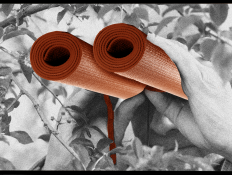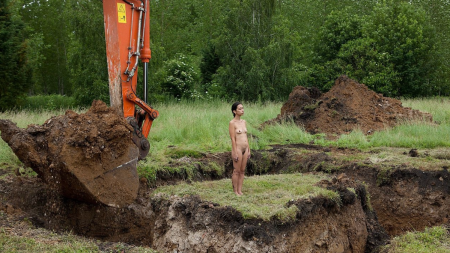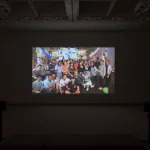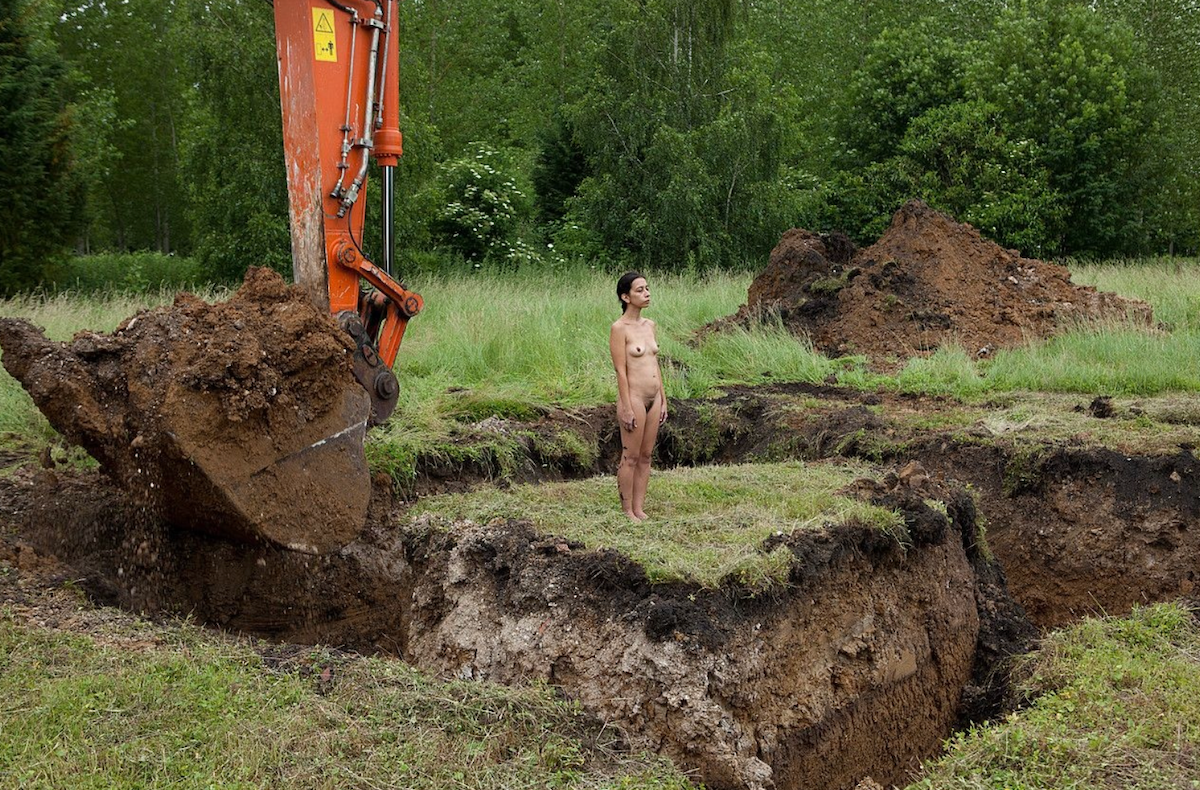
In 2013, Regina José Galindo attended the trial of José Efraín Ríos Montt and Jose Mauricio Rodriguez Sanchez, who spearheaded the Guatemalan coup d’état in 1982 and then led the country until 1983. Ríos Montt and Rodriguez Sanchez spoke of how the army dug up mass graves, then murdered Indigenous Ixil Mayan peoples and threw their bodies into the pits. Both were ultimately acquitted.
Galindo, like many Guatemalans, was deeply disturbed by their testimony—and ended up making a performance in response to it. For a 2013 work known as Tierra, she stood naked in the middle of a field as a bulldozer dug up the ground all around her, creating a tiny island made of earth. She stood still for roughly a half-hour, her body as vulnerable as the surrounding land and the corpses of Ixil Mayans once buried in places like it.
For Galindo, the piece was a form of resistance. During the performance, which can now be seen via video documentation, she does not waver, even as the tractor brings its arm close above and around her. Galindo has practiced meditation exercises in which she imagines roots growing from her feet. Here, she clings to what little she has left.
More than a decade on, Tierra was recently presented at MoMA PS1 in New York earlier this year amid widespread talk of a different genocide, this one in Gaza, where Israel has killed more than 40,000 people since the October 7 Hamas attack. In an interview with ARTnews, Galindo called the work “a piece that questions one genocide to question all the others.”
Moreover, she said, she wanted “to show an artwork where a woman shows her naked vulnerability, defending a piece of land, while every day we see men and women defending their land. It brings that dynamic where there can be interactions of solidarity between Guatemalans, the New York audience, and the people of Palestine. And also, the recognition of erased histories, of people who have been forgotten by empires and their history.”
Galindo’s art of the past two decades is characterized by its explicit political and critical content, often using her body as a tool for confrontation and social transformation. In 1999, for example, she performed Lo voy a gritar al viento (I Will Yell It To The Wind), in which she hung herself from a bridge while reciting her poetry on the abuse that women have endured in Guatemala. In 2004, she underwent surgery to reconstruct her hymen for her work Himenoplastia. And in 2005, she carved the word “PERRA” (BITCH) into her right leg using a knife, expressing her condemnation of the acts committed against women in her country.
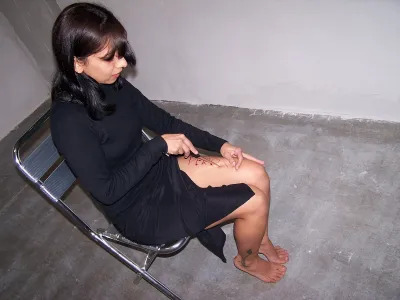
Although Galindo started as a poet and illustrator, she shifted to performance art after receiving an invitation from her friend and colleague, Jessica Lagunas, to participate in a 1999 group exhibition, “Proyecto de Arte Independiente” (Independent Art Project). Galindo began collecting news articles about gender abuse, rape, and hate crimes against women in Guatemala between 1998 and 1999, and Lagunas introduced to her the performance art of Ana Mendieta, Marina Abramović, and Chris Burden, all of whom also used their bodies to comment on power.
Galindo planned to write poems based on all that she had been studying, but with this new knowledge and all the desire and rage she had to spare, she ended up staging a performance: El dolor en un pañuelo (The Pain On a Handkerchief),for which she was tied to a vertically standing bed as images of the news articles were projected onto her naked body. The performance articulated the artist’s denunciation of systemic, recurrent violence against women, which continues to this day.
While Galindo remains best known for difficult, agonizing performances like Lo voy a gritar al viento, the one where she hung herself from a bridge, other works by her are gentler by comparison. With each iteration of her work Aparición (Apparition), Galindo blurs the lines between performance and sculpture with her “non-permanent statue,” presenting a human body with little-to-no recognizable characteristics while standing still. The performer acts as a monument to a violence or injustice that corresponds with the space in which she inserts herself, interrupting the narratives in place.
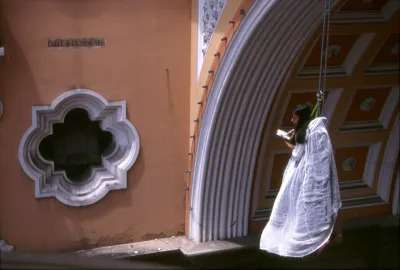
Her most recent iteration of Aparición was done in 2022, and involved 43 women covered in large cloths. These women appeared in public spaces to mark the 43 feminicides that occurred in the year prior in Spain. The piece puts its performers in a position of resistance and resilience in opposition to the powers that seek to devour them. This concept of the non-permanent statue also informs Galindo’s work previously on view at PS1, Tierra.
As her career has progressed, Galindo has expanded her focus beyond Guatemala, where she is still based today, to other communities abroad. Galindo just opened a retrospective solo exhibition, “Descolonicemos el mundo” (Let’s Decolonize the World), at La Panera Art Center in the Catalan city of Lleida. Among the artworks that span through the last twenty years of her production, Galindo presented Fruta Amarga (Bitter Fruit) which was commissioned specifically for this exhibition. The project sheds light on the thousands of migrant seasonal workers who arrive from abroad (generally Africa) to collect the harvest of fruit in the region; laborers who often do not have a place to rest at night as a result of system racism, unfair treatment, and low wages.
In preparation for this, she conducted historical research and connected with local efforts such as VIGEO- Visualidad and Geoestética en la Era de la Crisis Ecosocial (Visuality and Geo-aesthetics in the Age of Ecosocial Crisis), a project from the Geography and History Department of the University of Barcelona, and Fruita amb Justícia Social (Fruit with Social Justice), an organization that defends and fights for the human rights of the fruit harvesting workers in Lleida, to further vocalize these struggles and create new ties towards collective efforts. In Fruta Amarga, Galindo sleeps in a public plaza in Lleida, resting on a bed of fruit collected by the day laborers. In doing so, she focuses on the susceptibility, lack of safety and prejudice suffered by the migrant seasonal workers.
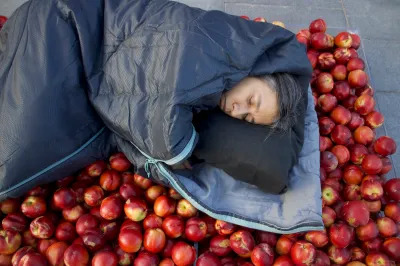
No matter what her subject matter might be, however, Galindo is focused on the vulnerability of people. This means her work “always ends up being about colonization in all its forms,” she said—even though she is not explicitly addressing it.
But there is also a warmth to Galindo’s art that is not always obvious. As I read about Galindo’s work, I kept thinking of an Audre Lorde quote that I currently have as my phone’s wallpaper: “I want to live the rest of my life, be it long or short, with as much sweetness as I can decently manage, loving all the people I love and doing as much as I can of the work I still have to do. I am going to write fire until it comes out of my ears, my eyes, my nostrils…everywhere. Until it’s every breath I breathe. I’m going to go out like a fucking meteor!”
Galindo’s performances and dedication to her craft emanate this intense desire to question colonial and patriarchal narratives in power. “We all have to invent our own language of creation,” she told me, “because everything is done and said by those in power. Then we contextualize and adapt the ideas to our own criteria and circumstances. It is from there that new ideas or new projects and results emerge.”
Following Censorship Controversy at Aichi Triennale, Artists Discuss Why They Removed Their Work–and Then Reinstated It
‘Contemporary Art from the Colección Patricia Phelps de Cisneros’ at Museo Amparo, Puebla, Mexico

How Véronique Nichanian Built Hermès Menswear One Stitch at a Time

Bella Hadid Succeeds Julia Roberts as Chopard Brand Ambassador

Tests show these portable phone chargers are a waste of money – do you own one?

U.S. Open 2 A.M. Finishes Persist Despite New Late Night Policy
